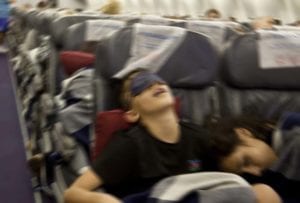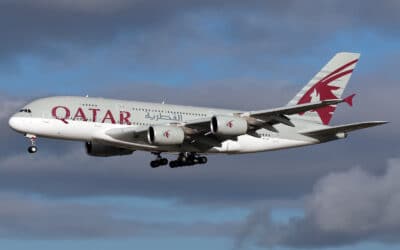I have 12 common-sense sleep secrets that will help you get to sleep and stay asleep on long-haul flights.
 Later this year, I’ll be on some very long flights, lasting from twelve to almost twenty hours. I’ve been on long flights before, but almost twenty hours will be a new record for me. Flights that long mean that while aloft, sleep is essential or I’ll be mush on arrival.
Later this year, I’ll be on some very long flights, lasting from twelve to almost twenty hours. I’ve been on long flights before, but almost twenty hours will be a new record for me. Flights that long mean that while aloft, sleep is essential or I’ll be mush on arrival.
Here are my twelve sleep secrets for long flights:
Before you begin your journey —
When making your long-haul flight reservation, if you can afford it, upgrade to business class, plus choose your seat wisely, no matter what class cabin you’ll be in.
Consider upgrading:
If you can upgrade to a lie-flat business class seat, it’s worth it for long, international flights. While none quite equal a quality hotel bed, with a blanket and a pillow they’re as good as a small bed in a hotel.
Choose your seat carefully:
For long flights, some suggest window seats. They give passengers the plane’s side to lean against to help you sleep. I choose aisle seats to avoid climbing over others in my row to get to the lavatory or periodically stretch, etc., while they sleep.
I also avoid seats near galleys and lavatories, as they have too much activity and noise that can keep anyone awake. For some, “recline” on planes is a dirty word. On long flights, however, during the time that most people sleep, recline complaints are rare. If you plan to recline to be in a better sleeping position, consider avoiding seats directly in front of bulkheads as they often have a limited or no recline. Sometimes, planes used for long haul flights have bulkhead mounts for bassinets for babies. If you’re on one of those planes, consider avoiding seats near bulkheads to stay clear of noisy families with crying babies and infants.
Use SeatGuru.com or another seating chart website to learn about specific problem seats that your flight may have.
As you get ready to leave on your journey —
The clothes you choose to wear will greatly affect your comfort and ability to fall and stay asleep.

On long flights, put comfort over style. Wear comfortable clothing. Don’t wear tight fitting clothes. They’re not conducive to sleep. I wear compression socks for comfort and so I can take off my shoes while I sleep.
Dress in layers:
I always dress in layers for air travel. It’s impossible to know in advance how comfortable the cabin temperature will be during your flight. Even in summer, I’ll wear a warm-up jacket on the plane in case it’s too cold for me. If it’s too warm, I can take it off.
Bring a pillow and a sleep kit to help you sleep on your long plane flights.
Bring a pillow:
Many air travelers swear by memory foam-based travel pillows. They’re wonderful for sleeping. But they don’t pack well because they’re too bulky. To make room for stuff in my carry-on and personal bag I use an inflatable donutpillow. I don’t blow it up completely to keep it a bit soft. It has a soft cloth cover for comfort. I also bring an inflatable wedge pillow to support my lower back. Even in premium economy, seats don’t recline much. A wedge pillow lets you move forward in your seat, yet have back support, for more comfortable sleeping.
Create a sleep kit:
I keep my sleep kit items in a typical travel organizer bag. Noise, including engine noise, conversations and people moving about the cabin, in and out of the galley and lavatory is a problem preventing sleep for many on jetliners. My primary method of blotting out plane noise and cabin conversation is to wear a noise canceling headset, even if I’m not listening to anything. If it’s particularly noisy, I’ll plug them into my iPhone and use my “white noise” app . As an alternative, you can bring foam earplugs to block cabin noise.
You never know who might sit near you with plans to stay up all night with their light shining brightly. I also pack a lightweight, comfortable, 3D eye mask to block the cabin light from my eyes. I prefer the 3D masks. They don’t lie directly on my eyes like the silk masks some travelers prefer. In a pinch, a pair of sunglasses can also help block the light. I also keep a ball cap in my kit. To me, there’s nothing worse than having cold air from the airplane’s vents blowing directly on my head while I try to sleep.
Bring a boring video on a tablet:
Many say that when they’re home if they turn on their TV and begin to watch a boring movie, they’re asleep in minutes. If that’s you, duplicate that on your flight. If you bring a tablet on your trips, put a boring movie on it. Use it when you’re ready to sleep and hopefully, you’ll be asleep in minutes.
While you’re in the air —
Steer clear of alcoholic and caffeinated beverages which can prevent you from falling asleep as well as awaken you early.
Forget alcohol and caffeine:
Because caffeine is a stimulant, avoid it, if planning to sleep on your flight. Caffeine and alcohol are diuretics. Unless you want to be awakened often to go to the lavatory, avoid them to reduce your need to urinate. So, while flying, particularly on long flights, skip the coffee, tea and colas, so you can get a decent sleep.
Stay hydrated:
Dehydration can make you feel overly tired and irritable. It can also cause headaches, making it harder for you to fall asleep and stay asleep. In addition, planes are dehumidified purposefully to prevent fuselage corrosion. Drink plenty of water and liquids, other than alcohol and caffeinated beverages, to stay hydrated and help you sleep on the plane. Staying hydrated has an added benefit. According to physicians, when you’re dehydrated, your nasal passages become dried out. That can cause you to embarrassingly snore. Staying hydrated can reduce your tendency to snore on the plane.
Sometimes it will be important for you to tell passengers in your row and flight attendants that you’re going to sleep, so you can sleep and stay asleep.
Send an unmistakable message that you want to sleep:
Sleeping on planes can be difficult if you’ve got a night owl in the seat next to you, or someone who is restless and wants to talk. I found if I get out my eye mask, and say as I put it on, “Sorry, it’s bedtime now,” they get the message.
Tell the flight attendant you’re going to sleep:
On some flights, a middle of the night snack and drink is served. Let your flight attendant know you don’t want to be disturbed for it.
Wear your seat belt whenever you’re in your seat, either sitting up or lying down, even when a blanket is covering you.

Earlier this month, I wrote about the serious issue of severe air turbulence. Severe air turbulence can occur any time on a flight, even while you sleep. Any time you’re in your seat, either sitting up or lying down, fasten your seat belt. If you’re asleep under a blanket fasten your seat belt on top of the blanket. A flight attendant won’t disturb you to ensure you’re wearing it.
My commonsense sleep secrets won’t guarantee you’ll have a great sleep on your next long flight, but they will certainly help you fall asleep and stay asleep while aloft. Happy landings.
READ ALSO:
Donate to Travelers United. Keep us working for you to make travel better
Airline consumers really want to know the full cost of travel
After many years working in corporate America as a chemical engineer, executive and eventually CFO of a multinational manufacturer, Ned founded a tech consulting company and later restarted NSL Photography, his photography business. Before entering the corporate world, Ned worked as a Public Health Engineer for the Philadelphia Department of Public Health. As a well known corporate, travel and wildlife photographer, Ned travels the world writing about travel and photography, as well as running photography workshops, seminars and photowalks. Visit Ned’s Photography Blog and Galleries.



